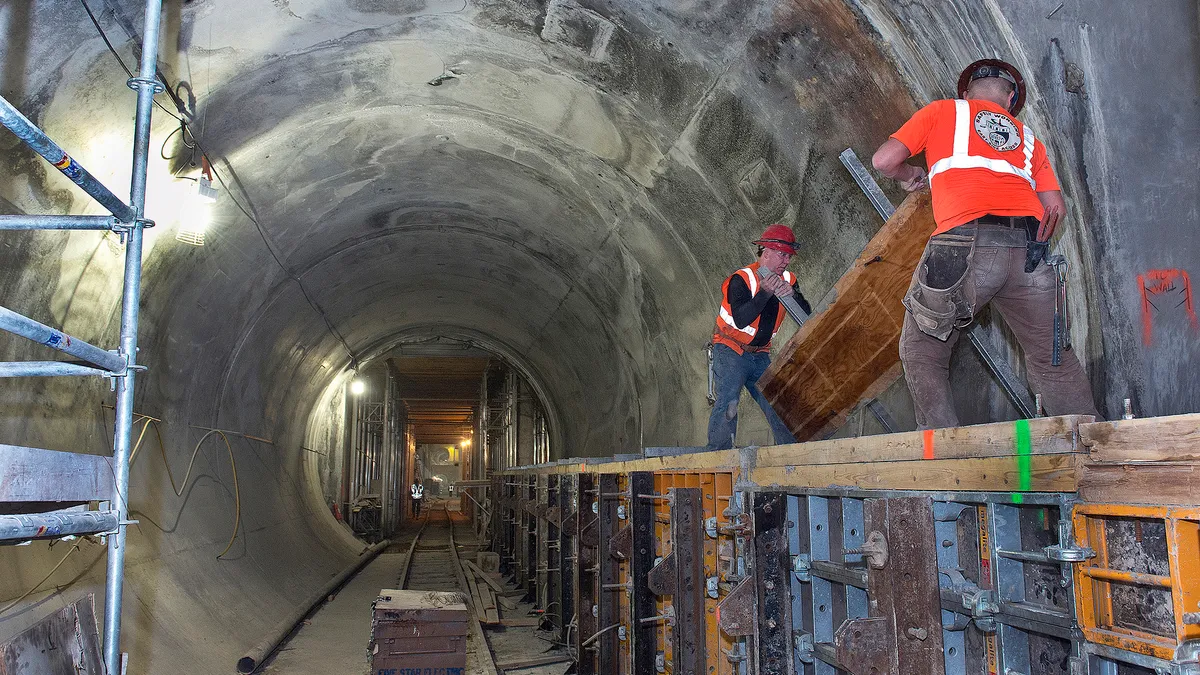Dive Brief:
- As part of its Transformation Plan, New York City's Metropolitan Transportation Authority (MTA) is transferring 430 employees to the agency's new Construction and Development department, reported the New York Daily News. The change is effective Monday, Dec. 16.
- Until now, the MTA's capital projects have been handled by construction personnel within its divisions, such as the Long Island Rail Road, New York City Transit and Metro-North Railroad. The new department, according to the Transformation Plan, will help the MTA pursue alternative project delivery methods, including design-build.
- The centralization of construction operations under a new department is one of the six primary changes to the way the MTA does business. The others are refocusing safety, operations and maintenance responsibilities; creation of an engineering department to ensure the agency's infrastructure projects are high-quality and sustainable; establishment of a customer service-focused department; creation of uniform, MTA-wide design and operations standards; and centralization of operating and support functions.
Dive Insight:
The MTA came up with a plan for reorganization after New York state lawmakers mandated the agency do so by June 30, 2019, and approve such a plan by July 30, 2019. The decision came on the heels of bad press about how disorganization and inefficient legacy practices at the MTA had been pushing up costs, making New York City the most expensive place in the world to build subway systems. Delays in decision making and in the execution of capital projects reportedly had even forced some contractors to add an additional 25% "MTA fee" to their proposals.
For lawmakers and the public, the need for an agency overhaul was made more urgent given that the MTA spends tens of billions of dollars on capital projects. In September, the MTA released its 2020-2024 budget and plans on investing $51.5 billion during the life of the five-year capital plan.
The MTA's Transformation Plan acknowledges that the employee reorganization will also result in some challenges like the portability of pension programs; updating the terms of agreements with agencies outside the MTA; renegotiating some collective bargaining agreements and work rules; and reworking pay scales.
The MTA's current approach to the delivery of capital projects, according to the Transformation Plan, is "slow, bureaucratic and costly," while the new strategy will create one point of accountability and make it possible for the agency to complete its projects faster, more reliably and more cost effectively.
Project CEOs will usher each project from concept to close-out and will determine project delivery methods, with maximization of design-build; try to increase competition among suppliers; bundle projects with the objective of lowering costs and maximizing value from subs and suppliers; streamline specifications and reduce the number of custom-designed projects.
The emphasis on design-build, said attorney Erik Ortmann, vice-chair of the construction law practice at Kaufman Dolowich Voluck LLP in New York, ties into a mandate laid out in the details of the MTA's budget. Any project worth more than $25 million must use design-build. The MTA, he said, believes that using design-build will speed projects along, but it also has the benefit of shifting more risk to their contractors.
Also part of reducing risk are the MTA's new debarment regulations, Ortmann said, which are new rules that many contractors oppose. Within certain parameters, contractors that are delayed in delivering their work or that submit invalid claims will be debarred from performing agency work for five years.
As for the rest of the MTA's Transformation Plan, the contractors that he deals with are taking a wait-and-see approach. "It's still brand new." he said, "I think they're optimistic that you'll have people who are professional, who want to move things forward and maybe less red tape."
But any program will be a challenge for the MTA considering the scale of the work the agency has in front of it.
"New York City has an aging infrastructure that's very well used and, as a result of that, has wear and tear and has to be maintained and modernized," Ortmann said. "The challenge that they've had, in addition to labor costs being relatively high, is getting this all fixed at a cost that isn't going to be impossible to bear. I'm not sure that it's a challenge that is ever going to be fully resolved."











